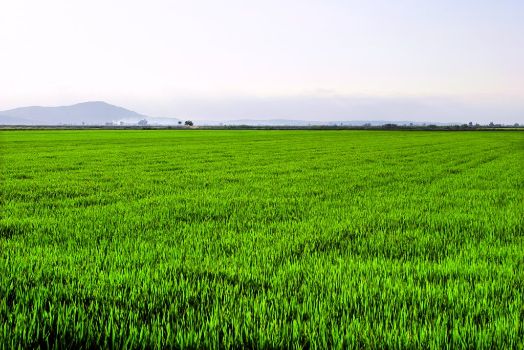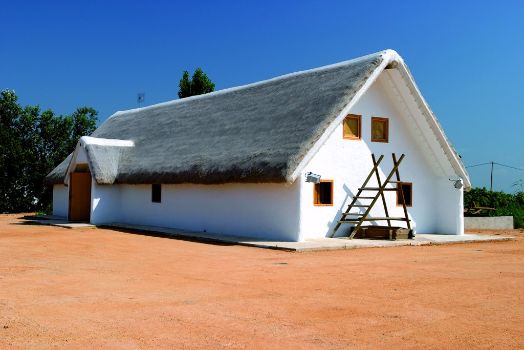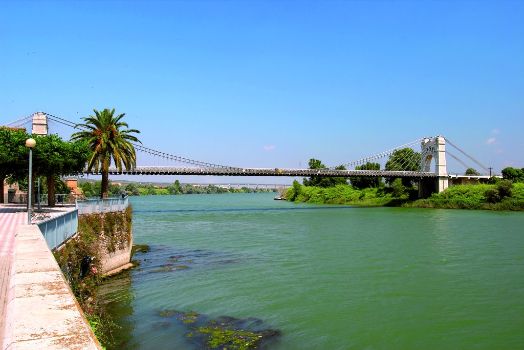Net of Natural
Trails

Stage 41: Tortosa - Amposta
Description
Arriving at the Ebro Delta
Starting from the Teodor González de Tortosa park, walk along the banks of the Ebro to the Bimilenario bridge, where the GR 99 follows the Mig path, the traditional route from Tortosa to Amposta, which runs between orchards and houses, accompanied by the important canal on the left. After the village of Campredó (consisting of dispersed agricultural hamlets such as Font de Quinto, which preserves its rural physiognomy and interesting monuments), you will return to the riverbank and then cross under the railway bridges and the A-7, which mark the beginning of the delta’s rice cultivation. Nearby is Amposta, which is reached by crossing its attractive suspension bridge.
The starting point of this stage 41 is interesting; it is located on the medieval market of Tortosa, next to Teodor González park. From here it continues downstream until it reaches the Bimilenario bridge, over which the Ebro crosses the ring road between the C-12 and the C-42. On the left, inside the support, is the Ebro Museum. Continue under the bridge for 350 m eastwards and then follow a path that leads off to the right: this is the Mig path, the traditional route from Tortosa to Amposta, which runs between orchards and houses. You will need to turn right at the next two crossroads which the hikers will meet, thus going around an industrial estate that leads to a roundabout, next to the C-42.

You need not enter it, since you will need to take the path descending from the left which, within a few metres, links with the canal on the left. Further on, when the canal and its service roads approach the Ebro, take a diversion to the right that leads to the bank, which will offer travellers beautiful views of the riverbed. For now you must leave the canal, although not for long, since barely two kilometres later the route will return to it.
Your eyes will now be filled with the powerful image of the horticultural landscape on the right bank of the canal while the left-hand side is completely different, dominated as it is by the large Baix Ebre industrial estate, very near the village of Campredó. This village was formed by the clustering of dispersed vegetable gardens, of which Font de Quinto and Raval del Pom retain their personality. If you wish, you can reach it from a signposted junction.

Further on, when the canal again approaches the Ebro, an access that allows you to enter the Font de Quinto hamlet. Two buildings of interest stand here: the tower of Ayuso, which was formerly used as a lighthouse and is visually linked to the tower of La Carrova, on the opposite bank of the Ebro, and the Prat house, also known as the Lonja (market). Both buildings date to the 13th century and are in the Templar tradition.
Indeed, it is at this access that the Nature Trail separates from the canal’s service track to again approach, via a path on the right, the bank of the Ebro. After passing a gas pipeline that crosses the river, you reach the La Cantera ravine, where the GR 92 Sendero del Mediterráneo (GR 92 Mediterranean Path) is marked, from l’Ampolla.
After crossing the canal again, a panel notifies you that from that point on you are entering the Ebro Delta. The rocky ledge on which one of the railway bridge supports stands is considered coastline that has existed since before the delta began to emerge.

The path leaves the canal and heads northeast through the La Cantera ravine, although it then leaves it to pass under the railway and then over the AP-7 motorway. From here it can be said that the delta begins its flooding and you will notice the first rice fields.
The itinerary continues, seeking further on the hard shoulder of the N-340a road on which the remainder of the stage will run, under the watchful eye of the well-known Pont Penjant (suspension bridge) of Amposta, whose town centre is one kilometre away, on the other bank.
Amposta is a town of around 20,000 people, the capital of the district of Montsià; it has all kinds of services and communications, as well as a very interesting Delta museum. It was an Iberian site when the delta began to form, although today the Ebro’s course runs more 30 km over land reclaimed from the sea.
Sites of interest
Puntos de interés
Infrastructure
Municipality
Hostel
Profile

Highlights
Further information
The Ebro Delta
The Ebro Delta began to form around 1,500 years ago, thanks to the numerous and important deposits that the river brought from the high peaks that fed it to the sea. With a surface area of 320 km2 of plains and extensive rice fields, the Ebro Delta is one of the most important aquatic habitats in the western Mediterranean and the Iberian Peninsula. A wetland of great interest for lovers of ornithology, nature and fishing. More than 300 different species of birds nest or simply rest and feed there during migration seasons. Man has been transforming and humanising this landscape, inhabiting and cultivating 75% of its area. To harmonise the natural values of this space with its exploitation, the Delta de l’Ebre Natural Park was created in 1986.





